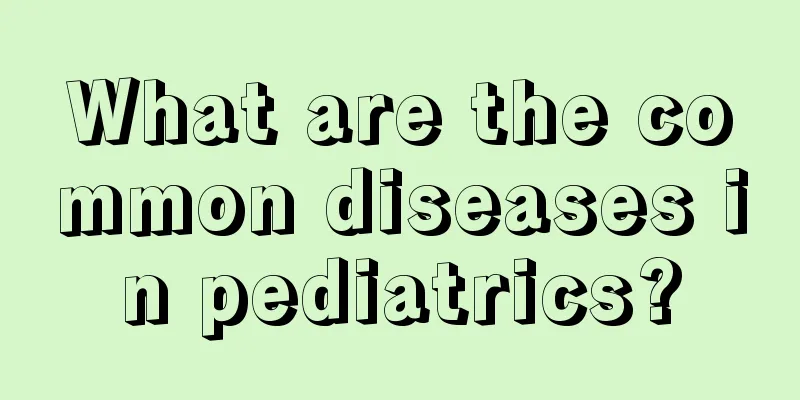What should I do if my baby's ears bleed?

|
Bleeding from a baby's ears is generally a symptom of otitis media, which has a great impact on children. If not treated in time, it may even have a certain impact on the child's hearing. Therefore, once a baby's ears bleed, it is necessary to first confirm whether it is otitis media. If so, then an active treatment plan must be taken to treat it. The following is a detailed introduction to the treatment of otitis media. 1. Clear the middle ear effusion and improve the ventilation and drainage of the middle ear 1. Tympanic membrane puncture and fluid extraction: local anesthesia is used for adults. Use a No. 7 needle with a shorter needle tip bevel to pierce the tympanic cavity from the front and bottom of the tympanic membrane under sterile operation to aspirate the effusion. The puncture can be repeated if necessary, and glucocorticoids can be injected after the fluid is drawn. 2. Myringotomy: If the liquid is thick and the tympanic membrane cannot be completely aspirated, or if the child is uncooperative and the tympanic membrane cannot be punctured under local anesthesia, a myringotomy should be performed. The operation can be performed under local anesthesia (general anesthesia is required for children). With a myringotomy. Use a myringotomy knife to make radial or arc-shaped incisions in the anterior and inferior quadrant of the tympanic membrane. Be careful not to injure the inner wall mucosa of the tympanic cavity. After the myringotomy, all the liquid in the tympanic cavity should be drained out. 3. Tympanostomy tube placement: If the condition is prolonged or recurrent, or if the patient has glue ear or is suffering from head radiotherapy and it is estimated that the Eustachian tube function will not return to normal in the short term, the initiator should undergo tympanostomy tube placement to improve ventilation and drainage and promote the restoration of Eustachian tube function. The ventilation tube is usually left in place for 6-8 weeks, and can be as long as half a year to one year. The ventilator tube is removed after the Eustachian tube function is restored. Some patients can expel the ventilator tube into the external auditory canal on their own. 4. Keep the nasal cavity and Eustachian tube open: Use 1% ephedrine solution or alternate with beclomethasone dipropionate aerosol for nasal drops (sprays) 3-4 times a day. 5. Eustachian tube expansion: You can use the nasal pinching and air blowing method, the Bosch ball method or the catheter method. Prednisolone can also be insufflated into the pharyngeal opening of the Eustachian tube through the catheter, once every other day, 1 ml on each side each time, for a total of 3-6 times. 2. Actively treat nasopharyngeal or nasal diseases Such as adenoidectomy, nasal septum correction, inferior turbinate surgery, nasal polyp removal, etc. Tonsils that are particularly enlarged and associated with recurrence of secretory otitis media should be removed. 3. Antibiotics or other synthetic antimicrobial drugs In the acute phase, you can use cefradine 0.5g, 4 times/d; ofloxacin 0.1-0.2g, 3-4 times/d. Children can use ampicillin 50-150mg/kg.d, given: or hydroxyampicillin orally, 0.15g, 3 times/d, the third-generation cephalosporin cefmet pixnet 0.25g-0.5g/time, 2 times/d, children 10mg/kg, 2 times/d. It has a strong antibacterial effect on pathogenic bacteria such as Haemophilus influenzae and Streptococcus pneumoniae, and can be used for those who are insensitive to other antibiotics. Glucocorticoids Oral dexamethasone or prednisone for short-term treatment. |
<<: Sleeping with your hands above your head
>>: The girl has secretions from her lower body
Recommend
What to do if your child is picky about food?
Parents must first be patient enough when it come...
What should I do if my child sleeps during the day and not at night?
Babies often have a reversed day and night situat...
How to treat rhinitis in children?
Studies have found that if a cold is not effectiv...
What to do if a 5-year-old child has eczema
Many parents actually don’t know what eczema is, ...
What should children eat to grow taller?
Children are in a critical period of growth and d...
Can neonatal rickets be cured?
Neonatal rickets is a relatively common disease. ...
How to treat gingivitis in children
Children in childhood prefer to eat all kinds of ...
What to do if your child has abnormal brain waves
When I took my child to check his brain waves, th...
What vegetables are good for children with fever?
Parents and friends all want to know what vegetab...
How long does it take for a child's bone fracture to heal?
Human bones can develop many kinds of diseases, i...
Are there any sequelae for premature babies?
The most obvious feature of premature babies is t...
Children cough at night
A child’s body and beauty are very fragile. Many ...
What should I do if my child sweats a lot?
Maybe the heavy sweating that many children have ...
Children's teeth clenching during the day
In fact, it is not only adults who suffer from te...
How can children improve their immunity?
This is an issue that many parents are concerned ...









